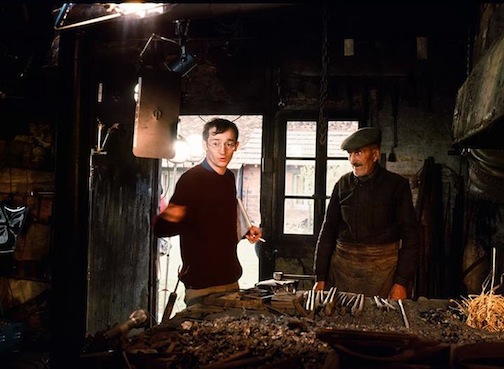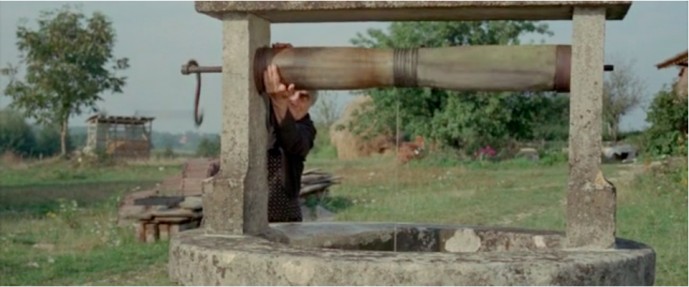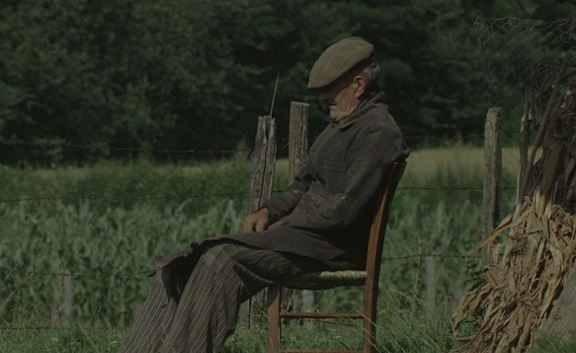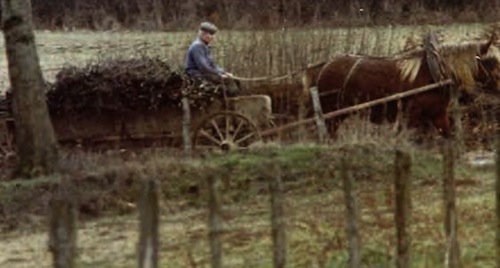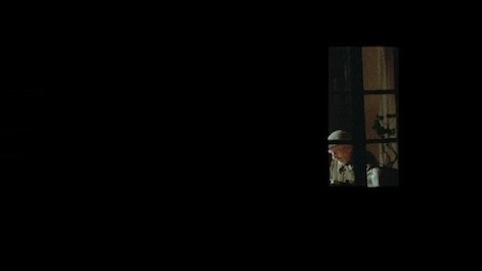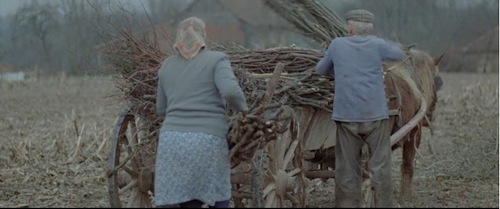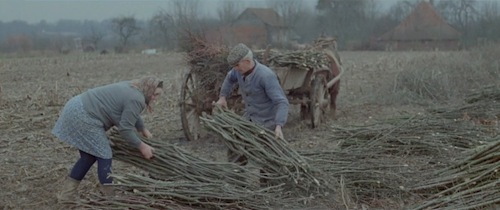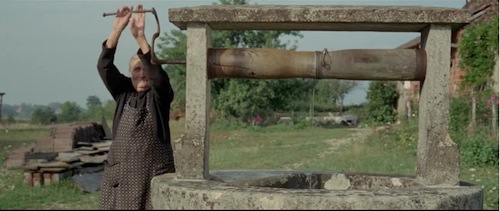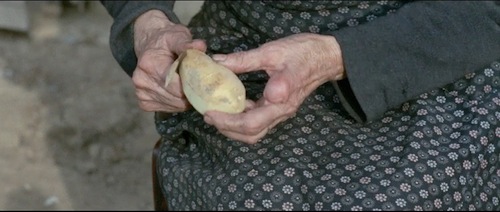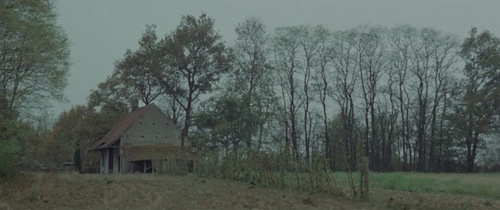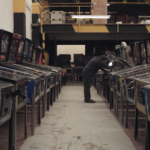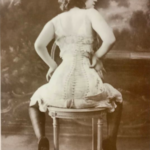“Cousin Jules”— A Rural Life
By Peter Monaghan
No one who has lived the farming life will tell you it’s idyllic. Rustic, perhaps — in the “rough as guts” sense. But bucolic? Not so much. Not when it comes to gelding bulls, dipping sheep, rising at dawn to milk cows, or dispatching a pig for the next 12 months’ dinners.
You might well prefer the life of a village blacksmith – such as the one memorably recorded in a landmark documentary film that is now out in a timely restored edition for institutional sales and rentals (from The Cinema Guild, in North America).
Timely, because in Le Cousin Jules (Cousin Jules), his 1973 work of 91 minutes, Dominique Benicheti not only depicted an elderly blacksmith and his wife living low to the earth with dignity through forthright toil in rural Burgundy, France; he also created a documentary film that was remarkable in its day, and remains so, now.
Cousin Jules has an odd history. From 1968 to 1973, Benicheti and cinematographers Paul Launay (Benicheti’s camera instructor at the Institute for Advanced Cinematographic Studies) or Pierre-William Glenn (who shot Francois Truffaut’s Day For Night and Small Change) recorded the daily lives of Jules Guiteaux (a second cousin — un arrière-cousin — of Benicheti’s mother) and Félicie, French farmers living alone in the countryside. Even in 1968, the couple had been married for several decades.
The project arose from necessity: after his studies at the Institute, Benicheti suffered a year of unemployment that prompted him to assess his prospects — and decide upon pursuing a film project of his own.
He recalled Jules Guiteaux, a son and grandson of blacksmiths, and his wife Félicée from summer-vacation visits to their farm near the village of Pierre-de-Bresse, in Burgundy. It was Jules’ metal work, in particular, that Benicheti recalled.
His team shot the film during three concentrated periods within five years, and then Benicheti readied it with what could hardly have been any concrete plans for wide distibution. When Le cousin Jules was released at the 1973 Locarno Film Festival, it was awarded a Special Jury Prize and hailed as a landmark in documentary filmmaking. It then screened at the New Directors/New Films festival in New York, the Los Angeles Film Festival, and the Moscow International Film Festival.
But its run stopped there.
Reception was one problem. Benicheti allowed that his film required patience and attention. And then, as now, expectations of documentary films were pinched. In 1975, Lee Atwell wrote in Film Quarterly that the film “inherits virtually none of the requirements of a feature-length or documentary film: there is no narrative, characterization, dramatic evolution, no acting to speak of, and the camera rarely moves from a fixed position with long sustained takes” [emphasis added]. It didn’t even have a musical soundtrack; (I notice that nor mine nor yours has one, either).
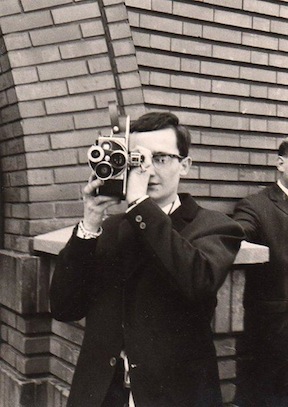 Benicheti did not render his film’s narrative, characterization, and dramatic evolution conventionally; as a result, his intentions escaped even able reviewers in more than one prominent journal. A Film Journal review erred when it praised the film as visually “immersive and magical” only to add that it was “an often fascinating ethnographic study of peasant survival and a pastoral life long gone.” This was hardly so, as agricultural archivists could have told the reviewer. The Guiteaux used metal tools and other equipment from the industrial boom of the 19th century; their way of life, far from “long gone,” was clearly viable, even if vulnerably poised.
Benicheti did not render his film’s narrative, characterization, and dramatic evolution conventionally; as a result, his intentions escaped even able reviewers in more than one prominent journal. A Film Journal review erred when it praised the film as visually “immersive and magical” only to add that it was “an often fascinating ethnographic study of peasant survival and a pastoral life long gone.” This was hardly so, as agricultural archivists could have told the reviewer. The Guiteaux used metal tools and other equipment from the industrial boom of the 19th century; their way of life, far from “long gone,” was clearly viable, even if vulnerably poised.
Those qualities of the Guiteaux’s life were consonant with Benicheti’s themes of perseverance and transience.
That Film Journal’s reviewer could consider Cousin Jules “ethnographic” further illustrates how liable the film’s singularity made it to being wedged into conventional categories. Even categorizing it as a “documentary film” really goes nowhere, any more than the Guiteaux’s old cart horse would if it were put behind its dray.
The larger issue with Cousin Jules, however, was its format. Benicheti had innovatively shot in CinemaScope with stereo sound and that made it conventionally unreleasable.
That was true in France, and certainly in the United States where few art-house theaters were equipped to play films in its format, and Benicheti declined to have his film seen in any other. So he could not find a distributor.
Reminiscing over the film in 1990, Dan Talbot, the founder of New Yorker Films and a fabled figure in New York art- and foreign-film presentation, succinctly evoked the “reality” that sets in when promoters consider running films that fall beyond public expectation, especially when they take on hurdles not easily cleared. Talbot wrote: “Benicheti organized a screening for me to learn if I would distribute the film. After seeing it, I said of course. But then reality intervened. The print I screened was the only print in existence. It cost $20,000 to make. The negative elements — in separate tracks – were at Technicolor in London. In order to make additional prints, the separate elements would have to be married. This, with an answer print, would run to $75,000. Benicheti would not allow the print he showed me, a pristine print from the original negative, to be shown unless I wanted to make additional prints to the tune of %20,000 a pop. And then, only a maximum of six to seven prints could be made. Striking additional prints would invite destruction to the negative. If one were to entertain global distribution, with the remote possibility that the film would gain a half-way decent sized audience, several hundred thousand dollars would have to be invested towards this end.”
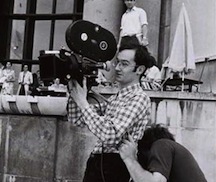 By way of absolution of steam-venting, Talbot cranked it up: “Go. Go show a film of this size to the universal airhead audience. I consider myself among the privileged few for having screened this film. I was unable to speak for two days after seeing it. I will never forget it. […] Twenty years later I still feel transformed by it.”
By way of absolution of steam-venting, Talbot cranked it up: “Go. Go show a film of this size to the universal airhead audience. I consider myself among the privileged few for having screened this film. I was unable to speak for two days after seeing it. I will never forget it. […] Twenty years later I still feel transformed by it.”
In short: Le cousin Jules was not commercially released, and never publicly shown again until 2012. It screened at the New York Film Festival that year and the Berlin Film Festival in 2013. That again drew glowing accolades of Benicheti’s film. In The New Yorker, for instance, Richard Brody called it “a tender and accomplished documentary. Benicheti makes images that are as poised and attentive as are his subjects. Each new activity that he reveals offers surprises that are fraught with the passing of time and the burden of labor.”
In the years between its creation and now DVD release and renewed screening, greater circulation of Cousin Jules surely might have inspired generations of documentary filmmakers to make films that were not only about subjects worth documenting, but more often made them in ways that inspired the alert, open-minded attention that critics then and now are quite certain Cousin Jules warrants.
Perhaps that will occur now that the film is out on DVD (released in the U.S. by the Cinema Guild for institutional sales and rental.) In The Village Voice, Zachary Wigon calls it “thoroughly transporting.” In The Wall Street Journal, Kristin M. Jones called the film “a quiet jewel. An indelibly immersive experience. Luminous and exquisitely framed, Benicheti’s patient shots of rural vistas often recall 19th-century French painting. One thinks of Vincent van Gogh’s radiant fields, Jean-Francois Millet’s laboring peasants, and Jean-Baptiste-Camille Corot’s precise but poetic landscapes. And yet Cousin Jules will also speak to many who have spent time in rural America. Combining objectivity with beauty, unsentimentality with warmth, it’s ultimately a tribute to life itself.” (In November 2013 in The New York Times, A.O. Scott expressed reservations about Cousin Jules, but only after falling into a tendency common to several reviewers of insisting that if a film is “slow,” it must be a comment on modern life’s rapidity, rather than a faithful reflection of the actual rhythms and pacing of lives as they were actually lived.
Benicheti began restoration of the deteriorating original print several years ago at Arane-Gulliver Laboratories in Paris, the lab he founded and worked at until the end of his life, in 2011, a little shy of 70. Much remained to be done; close friends and supporters took up that work. When the director of the 2012 New York Film Festival, Richard Peña jumped at the possibility of screening the premier of a restored Cousin Jules at the 2012 New York Film Festival, a group of admirers of the work raised the money required to push on to completion. (They restored the film in 2K DCP.)
Cousin Jules‘ key lesson for filmmakers even today is that documentary films capture and evoke their subjects and themes best when attentive to those, rather than those often hackneyed conventions that are commonly imagined to be essential for transition from film-festival flattery to placement on public-television or other spaces of “the market.”
Benicheti makes this case simply by exemplifying it. He employs no superfluous narrator who instructs viewers what to think. He provokes a general observation of the film medium, in which viewers view: Directors more rarely forego didacticism there than seems indicated. While arraying the sights and sounds of the aging man (Benicheti’s mother’s second cousin) working at his smithy, heating and bending iron bar to his purposes, Benicheti is himself bending the iron bar of film form to his subject’s expressive requirements.
First comes his film, not expectations of any particular kind of film.
That constitutes the distinctive and appropriate character of Cousin Jules. Not only does Benicheti deploy no narrator, he shows his subjects leading their complementary lives with barely a word spoken between them. When Jules’ wife, Félicie, grinds coffee in a manual press, Benicheti does not have her say: “We don’t have a Moulinex electric mill; we love the old ways.” The couple drink coffee or eat. They sit together or apart. The man gathers wood for his forge.
Still, Benicheti, in committing to a minute detailing of a slow, purposeful daily life, does not set his camera and go have a smoke; through careful pacing, framing, shot selection, and patience, he evokes his subjects’ lives foundation in decades of marriage and thoroughly familiar daily practice.
In the film’s critical reception, glowing praise has not necessarily meant particularly keen perception. For example, a repeated theme of reviews and appreciations from 1973 and recent months has been that Cousin Jules contains no drama. That is simply wrong, oddly unobservant, and apparently based in a misperception of the rhetorical force of the “slowness” of the film. The action is slow, the lives depicted are slow, but the film’s pace is appropriate to its subject matter. From there, the drama proceeds, and it runs deep with the pathos of resignation, yet forbearance. Cousin Jules runs the course of a non-literal day until an event slides it almost imperceptibly off its spindle. And then, the daily course of the couple’s life takes on a character and a significance that are as much as anything what Cousin Jules is about.
Here, a spoiler alert would underscore what that event is, and why the film simply is not a portrayal of a more “innocent time” that the elderly couple inhabit, out of time. Out of time? But the fruits of industrial manufacture of the previous century surround them, and Benicheti makes much of the materiality of their lives and their means — of hammering of mallet on iron, of huffing of hand-driven bellows.
So, it certainly is true, as Scott Tobias observes in The Dissolve, that “there’s something beautiful about the certainty of Jules’ hands as he strikes iron with the same rhythmic beats, or those times during the day when he and Félicie pause to share a quiet cup of coffee together.” But this does not amount to living out of time. On the contrary, the couple live suspended in their time; and like any time it is cannot remain removed from temporality. How could it? How could they? Spoiler alert.
Another: Benicheti brings into focus the transience even of hammer and iron, and of those who use them. J. Oberman noted this in ARTINFO: “The framed monotony of this dailiness show is transfixing. Everything on the Guiteaux farm has its place — Cousin Jules portrays a completely ordered rational life, which although loosely structured as a single (mainly autumn) day, is quietly ruptured by the gradual awareness of absence.” But observe, he recommends, what is going on when, late in Cousin Jules, Jules eats as a clock ticks and a cat perches nearby.
All this is to say that Benicheti crafts his film’s design and spare but significant plotting; he is intent on a dedicated use of craft for his thematic purpose, not to concoct some “poetic” or “painterly” quality or nostalgia for simpler times. Is his film really “an unabashed ode to the French countryside? The scenes of deliberate, routinized daily tasks and comforts distill the couple’s reality. In The Dissolve, Tobias rightly notes that Benicheti does not employ a “fly-on-the-wall” approach, but instead makes obvious use of such techniques as tracking shots and multiple camera angles.
But Tobias errs in viewing that approach as a way of constructing “staged” reality; rather, Benicheti repeatedly draws attention to the mechanics and craft of filming precisely to underscore and honor the mechanics and craft of the elderly couple’s quotidian, diurnal, circadian life — not pared down, but captured in its craft-based, vulnerable transience. Rather than construct a homily to simplicity or innocence, Benicheti presents the resolve and sadness in fleeting life.
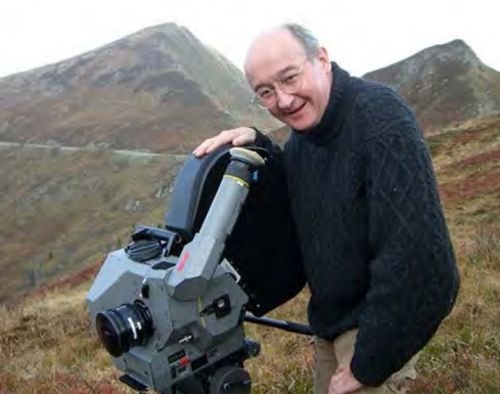
Benicheti in later life
n
After the mid-1970s stalling of the film, Benicheti had hardly sat and moaned. He went into the film after studying at the National School for Applied Arts, National Superior School of Fine Arts, and the Institute for Advanced Cinematographic Studies (IDHEC) in Animation, both in his hometown, Paris. He went on to direct and produce more than 30 films — documentaries, scientific films, institutional films, and animation — and he was a technical and creative consultant for many 3D and large-format films. His expertise in 3D technology contributed to the success of The Futuroscope Park in Poitiers, France, a theme park based upon multimedia, cinematographic futuroscope, and audio-visual techniques. He also was a consultant stereographer at Gower Studios in Hollywood.
He became best known in France for his brilliant deployment of 3-D and large-format filming. His La Revole, French Musical, A Fairy Tale, shot in 70mm with Stereovision lens, revolves around the last day of the Beaujolais wine harvest, and is considered the first French 3-D musical.
In 1975 he began teaching documentary filmmaking at Harvard University, and then turned his technical skills in visualization for several years to the challenges of visual representation in the work of the Jefferson Laboratories of Experimental Physics and the Harvard Smithsonian Center for Astrophysics.
He was instrumental in Jean-René Failliot‘s launching in 1976 of Arane-Gulliver, a leading European 70mm and special-format film laboratory. He designed and designed machine parts for large-format film. He left behind several screenplays for 3D and large-format films.
He had completed many, generally shorts. He made made Le prix de la liberté (20 min, 35 mm, 1994) for events and a permanent exhibit at the Arromanches Museum marking the 50th anniversary of the Normandy Landings of 1944. The film’s 360-degree panorama blends film by war correspondents with staged sequences of Normandy at that time.
La revole (20min, 70mm, 1997) was the first French 3-D musical comedy, a magical realist story set on the last day of the wine harvest. Benicheti made it for an exhibit at the Beaujolais Wine Museum.
In La grotte chauvet (20min, 70mm / 5 perf, 2000), Benicheti celebrated the discovery the year before of the 34,000-year-old Chauvet Cave. He designed and built a special motion control system for the 70mm camera that could fit in the entrance of the cave, reachable only by spelunking. The exceptional 3D sequences were produced using stop motion and long exposures.
L’oyssée magique (20 min. 70mm / 8 perf, 2009) was a “documentary hymn to nature” for former French president Valéry Giscard d’Estaing’s Vulcania Edutainement Park in Auvergne. Benicheti filmed it in Iceland, Colorado, French Guiana, the Grand Canyon, California, Vietnam, and France.
At the time of his death, Benicheti was making Pathé-Baby, blending fiction and documentary in a fantasy time-travel story. It was to feature 3D interviews of people long gone, observed by a 10-year-old girl.
Cousin Jules is singular among Benicheti’s films, and a rare film project, in general. Responses to it, at its first screenings and its recent ones, have made comparisons with Philip Gröning‘s Into Great Silence, Alberto Cavalcanti’s work for John Grierson’s GPO Unit, including Coalface and Night Mail, and Farrebique by Georges Rouquier, from 1946. In the New York Times, A.O. Scott likened it to Raymond Depardon’s 2008 documentary Modern Life. In the rewarding film webzine, The Dissolve, Scott Tobias suggests it “recalls that wellspring of all documentaries, Robert Flaherty’s 1922 silent movie Nanook Of The North, with its observational spirit and its ethnographic commitment to showing the longstanding traditions of an isolated people.”
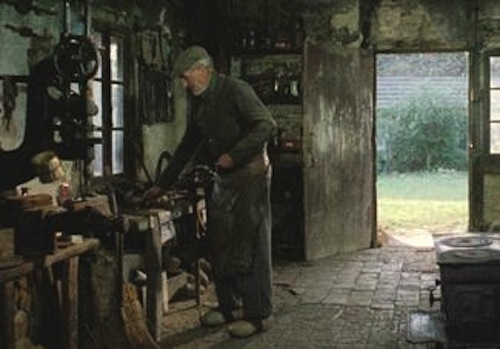 Precisely because it is so singular, its range of comparability can as readily be broad as narrow. So, in Artinfo, J. Hoberman suggested that it “evokes André Bazin in its use of duration and pure recording but another mid-20th-century French philosopher, Gaston Bachelard, in documenting the lived experience of domestic space and the ‘poetics of space.’”
Precisely because it is so singular, its range of comparability can as readily be broad as narrow. So, in Artinfo, J. Hoberman suggested that it “evokes André Bazin in its use of duration and pure recording but another mid-20th-century French philosopher, Gaston Bachelard, in documenting the lived experience of domestic space and the ‘poetics of space.’”
More than one reviewer of Cousin Jules’ current screenings also invokes Leviathan, a “sensory ethnography” of commercial fishing. In Village Voice, Wigon suggests that, “like Leviathan, which doesn’t tell a story but rather relates the sensuous immediacy of its subjects’ lives through raw, visceral images presented without narrative context, Cousin Jules concerns the essence inherent in actions, the way quotidian existence can be suffused with poetic peacefulness — and overwhelming sadness.”
The mood is one that archivists will likely recognize.
n
Information on institutional sales and rentals is on The Cinema Guild’s website.
Previous Post: FCC Announces New "Rules" for Closed Captioning
Next Post: The Guilty Pleasure of Wallowing in Quasi-Archives Constructed in Thoroughly Disapproved Ways

